Aurora
I was attracted to the "hybrid ready" ads on the Public Missiles Ltd. Aurora kit. And, I wanted to try dual deployment, so I purchased it and the CPR-2000 retro-fit kit. (If you don't know what hybrids are, check out the Hypertek Hybrid info.)
In addition to a nice hybrid-based dual-deployment rocket, this combination also produced a neat quick ejection system adapter to allow use of hybrid motors in rockets built for traditional delay ejection. This is such a cool idea, I think P.M.L. should kit it separately.
The Pictures

On June 14, at the annual ROC-stock launch in Lucerne, California hosted by the Rocketry Organization of California (ROC), I tried to launch the Aurora for the first time. This was my first launch with a hybrid motor and my first actual use of an altimeter for dual deployment. The launch was a disaster.
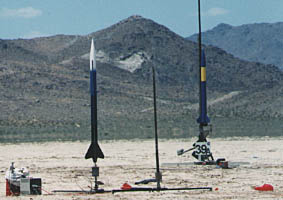 |
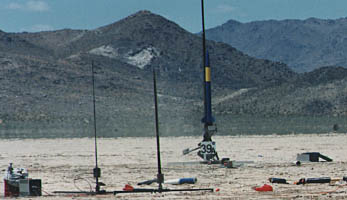 |
We never figured out what went wrong. The best guess was a problem with the hybrid ground equipment. The rocket appeared to take off normally, flew to about 50 feet, then ran out of steam and fell to the ground. The fall broke the brittle PML body tubing in many places and broke the CPR-2000 bay at the screw joint.
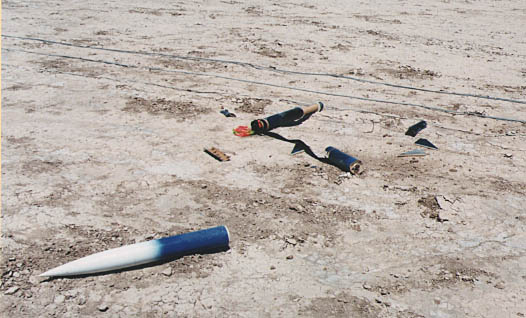
The Kit
The instructions for this kit were brief (one page, one side), but I didn't use them anyway because they were superseded by the detailed instructions with the CPR-2000 retro-fit kit. The CPR-2000 was a neat idea, but it has some flaws which will prevent me from using it again.
The screw-together part is made of somewhat brittle plastic, which broke when my rocket was blown over by the wind onto dirt (nothing else was damaged). I was able to glue it back together and fly the next day. Also, the design prevents use of an external power switch. The bay is designed to exactly fit the Adept ALTS25; in fact, it uses the ALTS25 circuit board as the main structural component. Below you can see where the screw part broke (luckily the altimeter was recoverable).
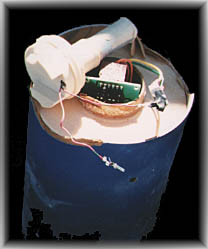
The neat thing was that the original ejection system for the Aurora is actually not really part of the rocket, but just an altimeter bay fitted for the Robbie's Rockets Loadable Ejection System (L.E.S.). Since I was replacing this with the dual-deployment CPR-2000, I didn't use the orignal bay at all. The original bay just fits over the top of a hybrid motor and replaces it in both function and position! This means you can use it and a hybrid in a rocket built for traditional delay-based ejection from a reloadable A.P. motor. I plan to adapt my Praying Mantis for Hybrid power, just by drilling two holes!
This idea is so cool, P.M.L. should kit it by itself. For the benefit of others who would like to build it, the instructions are reproduced below (or see the original instruction card). Note that the housing tube needs to fit over the N2O cannister and inside a standard 54mm motor mount tube. I don't know where this can be found. Mine fits tightly in the P.M.L. motor mount tubing.
| ejection system housing | |
|
Assembly and Set-up
Use epoxy or thick CA and accelerator to assemble the components as shown. Be sure the G-10 plate is perpendicular to the plywood disks. Drill a 3/32" hole through the plywood cap centered with the opening in the L.E.S. holder of the wires to pass through. Do not glue the tube to the housing. The cap should have a fight friction fit in the tube. Drill one or two small holes In the cap to allow the ejection charge wires to pass through. Use the supplied bolts, nuts, and stand-offs to mount the timer or altimeter to the G-10 plate. Disarm the timer or altimeter before continuing. Pass the ejection charge wires through the hole you drilled In the upper bulkhead and attach them to the timer or altimeter. Slide the LES ejection charge Into the holder. If It feels too tight, sand the ID of the holder by rolling up a piece of 120 grit sand paper and moving It back and forth. Friction fit the extended end of the ESH tube onto the N20 tank by wrapping a layer or two of masking tape around the top end of the N20 tank. Now arm your device and slide the housing tube over the frame. Slip the module over the top of the N20 tank. Slide the entire assembly into the motor mount tube of the rocket. Securely attach the motor to the rocket. When using a altimeter, make sure all the vent holes are aligned. |
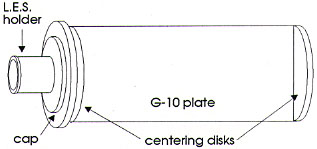 |
| When using an altimeter, vent holes must be provided in the airframe, motor tube, and housing tube. Make sure all holes are aligned before flight. | |
 | |
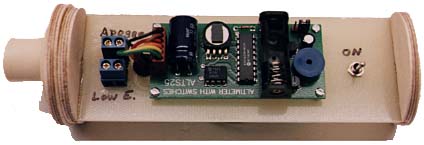
My bay with an Adept ALTS25 installed. The toggle switch is for power. The two blue terminal blocks are for the apogee and low elevation igniters. |

The bay slides into the tube from the top. |

The tube slides onto the top of the hybrid motor. |